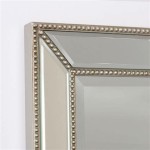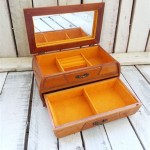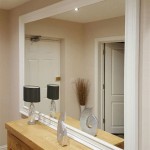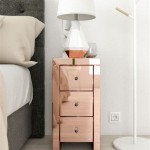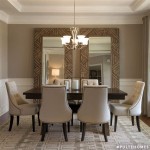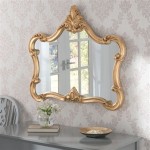Antique Vanity Tri-Fold Mirrors: A Reflection of History and Elegance
Antique vanity tri-fold mirrors, often referred to as dressing table mirrors or simply vanity mirrors, hold a special place in the history of furniture and personal adornment. These functional and decorative pieces have graced bedrooms and dressing rooms for centuries, evolving alongside changing styles and societal values. Understanding their history, construction, styles, and value can provide insight into both the artistry and practical considerations of these timeless objects.
Key Features of Antique Tri-Fold Mirrors
Several key features define antique tri-fold mirrors and contribute to their distinctive character. These features often aid in identifying the era of manufacture and assessing the value of a piece.
- Tri-Fold Design: The defining characteristic is the three-paneled design, allowing for adjustable viewing angles.
- Material: Commonly constructed from wood, often featuring veneers of mahogany, walnut, or oak. Higher-end examples might incorporate exotic woods or decorative inlays.
- Mirror Plates: Antique mirrors often feature imperfections inherent in early glassmaking techniques, such as waviness or bubbles, which add to their character.
- Hardware: Decorative hinges, knobs, and pulls contribute to the overall aesthetic and can often provide clues to the piece's age and style.
Historical Context and Evolution
The use of mirrors for personal grooming dates back centuries. Early examples were small and made from polished metal. The development of glass mirrors, particularly during the Renaissance, marked a turning point. As glassmaking technology advanced, larger mirrors became more accessible. The emergence of the tri-fold design allowed for a larger reflective surface within a manageable footprint, making it a popular choice for dressing tables.
Styles and Design Influences
The styles of antique tri-fold mirrors often mirrored the prevalent furniture styles of their time. Distinct periods are reflected in the materials, ornamentation, and overall form of these mirrors.
- Victorian Era: Characterized by ornate carvings, dark wood finishes, and often featuring bevelled glass edges.
- Art Deco: Streamlined designs with geometric shapes, often incorporating materials like chrome or Bakelite.
- Art Nouveau: Flowing lines and organic motifs, often featuring intricate inlaid decorations.
- Mid-Century Modern: Emphasized simplicity and functionality, with clean lines and minimal ornamentation.
Construction and Materials
The construction of antique tri-fold mirrors demonstrates the craftsmanship of bygone eras. Different techniques and materials contribute to the overall quality and durability.
- Woodworking Techniques: Dovetail joints, mortise and tenon construction, and other traditional joinery methods reflect the skill of the craftsmen.
- Veneering: Thin layers of decorative wood applied to a less expensive substrate, allowing for elaborate patterns and a luxurious appearance.
- Mirror Backing: Historically, mirrors were backed with silvering or other reflective materials. Over time, these backings can deteriorate, contributing to the antique patina.
Identifying and Evaluating Antique Tri-Fold Mirrors
Identifying the age and authenticity of an antique tri-fold mirror requires careful observation and research. Several factors contribute to the evaluation process.
- Construction Techniques: Examining the joinery, hardware, and overall construction can provide clues to the era of manufacture.
- Style and Design: Comparing the mirror's design with known historical styles can help determine its period.
- Condition: The overall condition, including the presence of wear, repairs, or replacements, impacts value.
- Provenance: Documented history or ownership can significantly increase a mirror's value.
Care and Preservation
Proper care and preservation are essential for maintaining the beauty and value of antique tri-fold mirrors. Careful handling and cleaning can help preserve their original character.
- Cleaning: Gentle cleaning with appropriate products and techniques is crucial to avoid damaging delicate surfaces.
- Handling: Avoid excessive pressure on hinges and frames to prevent damage.
- Environmental Factors: Excessive humidity, temperature fluctuations, and direct sunlight can negatively impact the wood and mirror.
The Enduring Appeal of Antique Tri-Fold Mirrors
Antique tri-fold mirrors remain sought-after items for collectors and decorators alike. Their combination of functionality, historical significance, and artistic merit contributes to their enduring appeal. These pieces offer a tangible link to the past and a unique decorative element for contemporary interiors.

Trifold Vanity Transformation A Makeover To See Prodigal Pieces

Antique Vanity With Trifold Mirror

Trifold Vanity Transformation A Makeover To See Prodigal Pieces

Vintage 1930s Art Deco French Vanity With Tri Fold Mirror And

Trifold Vanity Transformation A Makeover To See Prodigal Pieces

Vanity Dresser With Long Trifold Mirror Antique Victorian

Early 20th Century Antique Vanity With Trifold Mirror Chairish

Vintage Tri Fold Vanity Dressing Mirror Laundry Pe

Furniture Dressers Vanities 1900 1950 Antiques Browser Antique Vanity Shabby Chic Dresser Trifold Mirror

Antique Vanity Dresser Tri Fold Mirror With Bench Table Wooden Makeup Trifold


